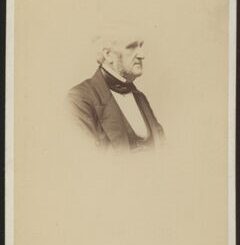The Shooting of Madeleine Cuisinaud
Of
The Flying Alizés
Blackpool June 1938
An Account of the Tragedy of Love’s Mutual Selfishness
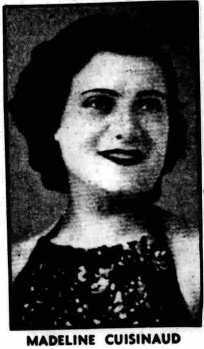
Madeleine is a member of the Flying Alizés trapeze act performing for the summer season at the Tower Circus, Blackpool. Her seemingly jealous and possessive husband had travelled from Paris to Blackpool on a weekend ticket and had smuggled an automatic revolver through customs checks into the UK. With this he had shot her in the neck and stomach at her digs on Caunce Street but she had survived her ordeal after a delicate operation and a stay in hospital. Unsuccessful in his desperate and enraged attempt to kill his wife, and exposed in his murderous intentions in front of her housemates, he put an end to his despair by shooting himself.
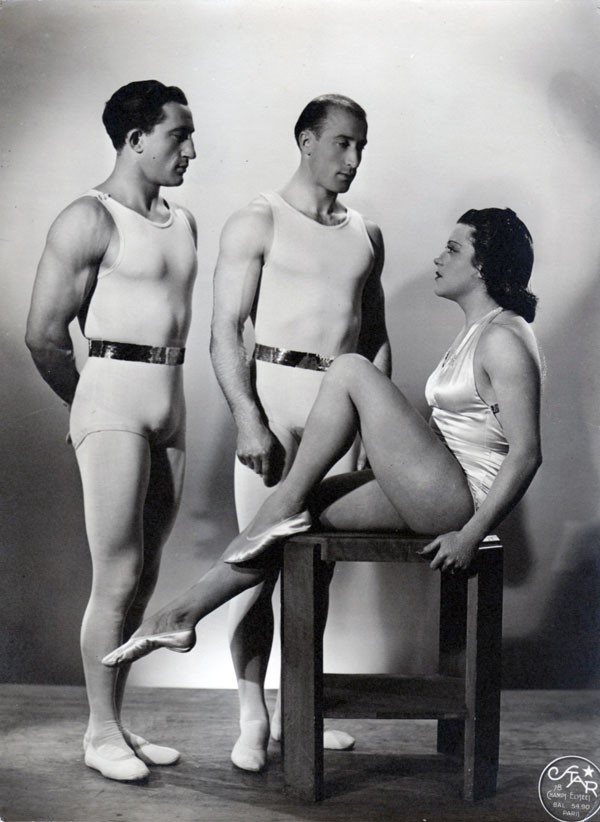
In the picture are Pierre Edouard Bouvet, the founder of the act, 28 years old, Louis Antoinie Souchot 32, and Madeleine Cuisinaud, an ‘olive skinned brunette’ about 25 years old though reported age varies from 25 to 29. They were performing as The Three Alizes, Les Tres Alizés, Die Drei Alizes, or the Flying Alizés, well known in Europe in all the famous circuses including the Tower at Blackpool. Translated from the French, Alizés, as a proper noun meaning ‘tradewind’, is quite descriptive of their spectacular and seemingly effortless aerial flight as renowned trapeze artistes and whose motto was, ‘nothing is impossible’. Together they combined to create the thrills of the aerial demonstration of trapeze in highly skilled entertainment, but unwittingly also creating in their association, a tragic and fatal, classic story of love commuted to jealousy and possession.
But for the trio, the muscular upper body strength for the male wasn’t just for showing off on the beach at Blackpool, it was essential for their profession and has been demonstrated as having direct life saving qualities when needed as things go wrong high above the arena when hanging by a thread of well-maintained and defiant muscle with an fearful and opened mouthed audience below. Madeleine’s part in the performance was the safer of the three and she was there not to just to look good in her own flimsy attire or to take to the occasional aerial flight, but mainly to throw the rope ladder of the trapeze with split second timing to the two men from the high platform. Her danger was not in the execution of the act itself but in the very fact that she was there in the first place. Madeleine was a ‘good girl’ and highly liked and respected by her companions, and for any sexual interest beyond admiration to take place within the threesome in its inevitable complications could compromise not just their profession, their contract and their livelihoods but also their very lives if distractions of relationships were allowed to creep into their performance. But Georges would not allow himself to believe that. She was his and his alone in her looks, her dress, her smile, her conversation and the support she provided to his male status in the social world. Not even the casual contact of her eyes should be the privilege for anyone else. He just wanted her back belonging to him and if not then it seems no-one else could have her.
The Three Alizes enjoyed a long career of about 40 years, though with differing personnel, from around the later 1920’s to the 1970’s and they entertained throughout Europe at all the famous venues. The line-up of personnel is not known previous to 1937 but in that year Pierre Buvet and Louis Suchot were joined by Madeleine Cuisinaud. Madeleine was married to taxi driver Georges Cuisinaud (other reports describe him as a chauffeur which is perhaps the same thing in translation) in Paris living in Rue Godefroy and it is not unreasonable to assume they led a conventional and largely conservative lifestyle up to that time. They had been childhood sweethearts, it is understood, and it is not known how long they had been married but one of her performers thought it might be as much as seven years. Virtually nothing is known about either about Georges or Madeleine but it is evident that Madeleine had left him to join the circus and work away while, in the beginning at least, remaining in a married state. It is hard to believe that Madeleine had never had anything to do with circuses or acrobatics previously as just a few months after joining she was on the high wire in a celebrated act, a profession which, in its essential precision, can take years to perfect even though her job was largely a ‘simple task’ of throwing the trapeze to the other two in timely manner though she did occasionally indulge in aerial acrobatics.
After Madeleine had joined the troupe, Georges must have been quite put out. It is not known how much was mutual consent or how much was Madeleine’s decision alone but from that time onwards she was working away from her husband and had toured in Europe which included a venue in the UK. By 1938 the troupe was back in England and contracted to a summer season at the Tower Circus Blackpool. It was here that the relationship with her husband, having now it would appear evident later on, been stretched to breaking point, inevitably snapped. Georges wanted her because she was his wife though it seems he was capable of seeing at least one another woman while his wife was away. Perhaps he felt cheated by Madeleine’s absence and needed the kind of companionship that his wife had given him. Madeleine wanted her freedom from, as much as Georges wanted her containment within, what would appear to have been a regularly banal and limited lifestyle in Paris.
On the weekend of Saturday of June 18th Georges had travelled from Paris to visit his wife and went to see her act at the circus. Her two colleagues were not aware of his presence until he had entered the dressing room afterwards. To other circus performers, it seems that in Georges there was an air of disapproval of her act, but Pierre and Louis had not noticed anything suspect. The four of them went on to share a reasonable weekend together and had gone for walk along the Prom before lunch on the Monday morning of that fateful day and, according to the landlady, they had all seemed happy together and laughing at the lunch table. Both Madeleine and Georges had appeared very happy together earlier in the day at the digs and there had been nothing unusual to arouse even a suspicion of anything untoward. Unknown to everybody concerned apart from Georges himself, he had somehow smuggled an automatic service revolver in to the country so it can be considered there was a premeditated intent on desperate and final action if he wasn’t to get his own way.
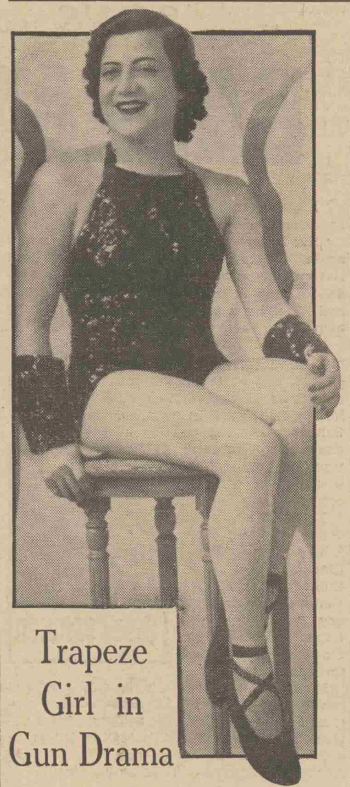
On the Monday afternoon, after they had all had dinner (which now might be described as lunch) together at their digs, and while they were playing cards together, Madeleine realised it was time to get ready for the show and she went upstairs and was immediately followed by her husband which would not in itself arouse any kind of suspicion since the two had shared the same roomover the weekend. Then the two men downstairs after being aware of a heated discussion coming from the bedroom further heard an urgent plea for help from Madeleine to, ‘Come quick, help me!’ Suchot and Bouvet rushed upstairs and found husband and wife together on the landing at the bedroom door in a heated discussion. It was then that they noticed a gun in Georges’ hand. Georges now distracted by the arrival of the two men as his real motive for being there was revealed, inadvertently gave Madeleine an essential opportunity to break free from her husband’s grip and she rushed to the bathroom. Pierre and Louis tried to bar the door to prevent him following her and he warned them to go away or he would shoot them too. In the same moment he fired at Madeleine at least three times injuring her as she tried to shut the door of the bathroom. She was hit in the neck and the stomach and collapsed to the floor in a faint. Both men for the sake of all their lives tried to wrestle the gun out of Georges’ hand and the gun went off in the tussle grazing Louis’ hand. At that moment Georges found his own opportunity to wrestle himself free. In panic then as his crime had been advertised beyond the secret containment of his own passion and was now available for everyone to see, he took to flight and shut himself in the bedroom a few steps away. Immediately afterwards another shot was heard. Entering the bedroom when all was quiet a little later, Georges was found to be dead. Two bullets were found in him as they forced their way into the room having to push the body slumped behind the door, out of the way to gain entry.
Outside, the noise of gunshots had been heard in the nearby Devonshire Road school yard where children were being lined up and an ice cream seller on a bike, James Waring of Fordway Ave, was passing when he heard a woman scream and three gunshots followed by two more. People ran out of their houses and then witnesses saw two young people, a man and a woman rush out of the house and hurry to a nearby phone box. At the time there was a confusion of how many shots had been fired but up to six shots in total had been fired it seems.
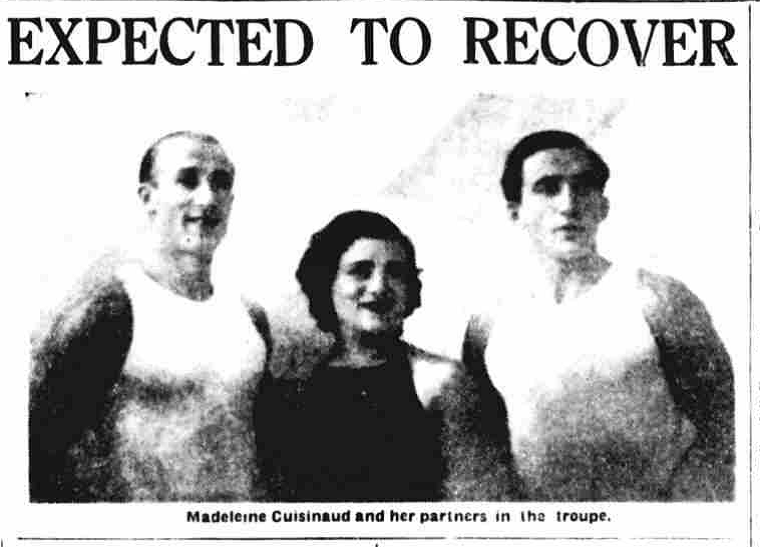
Madeleine was taken to hospital and the only word that could be discerned in her semi-consciousness at the time was ‘secreuse’ which was not understood by the police nor those attending to her at the hospital at the time, but which might have been ‘secours’. In the first instance it was reported that Georges Lockhart the ringmaster, himself no stranger to tragedy as he had seen his father crushed to death by an elephant, was able to act as interpreter as none of the artistes had even a small command of English. However later when she had recovered enough to be able to give her account, French speaking DI Toking and DS Morley were able to converse with her as well find out information from the French police in order to get a background on both Georges and Madeleine. Both Pierre and Louis had been allowed to visit her at the hospital as she had recovered a little, and she expressed concern that they wouldn’t have been able to carry on the act and was relieved to learn that another trapeze artist had stepped in until she was better. She had also asked them to lay a wreath at the grave where Georges was to be buried at the Blackpool Cemetery. Only she knew of the intimacies that she and her husband had once shared and perhaps there was room for the regret of circumstance which had first put them together, and that love which had seemed real and unbreakable at first, had ulitimately deceived them both.
The inquest had opened on the evening of the 21st June 1938 but Madeleine ha been too weak to attend. It might be a month before she was well enough to give evidence so the inquest was adjourned to July 19th when she was out of hospital and was able to give evidence. It wasn’t until the 12th July when she was well enough to leave Victoria Hospital and her two colleagues went to pick her up in a taxi. They went back to the address in Caunce Street where she was stated to be comfortable. Only a very delicate operation had saved her life. When she was able to attend the inquest Madeleine claims that there was no jealousy on the part of her husband and she thought that he had every confidence in her loyalty though the promotional pictures of the troupe might have had him worried without expressing as much to his wife. But the contradiction is that Madeleine had had words with him over another woman in his life after she had returned from England earlier in the year and from that point she had sought a divorce. A somewhat intimate letter from him as read out in court went; ‘My little woman, I have received your letter and I have never thought your decision was irrevocable.’ He hoped she would ‘reflect’ and not be ‘too hard’. He ends the letter with, ‘My Little God. I am closing my letter. I am not always naughty with you. This is just a joke in your life. Your little Georges.’
She was able to tell the inquest what had happened when Georges had confronted her on the landing of their accommodation. She had wanted to divorce now that their lives were running on different rails and her refusal to change her mind seems to have tipped him over the edge. She wanted the fulfilment of her profession and the freedom she was enjoying. It was not something that her husband could cope with. At the time of the assault he had shouted at her, ‘You must think me a fool to go back to France and leave you alone here,’ and then she said that her husband had suddenly gripped her by the throat, probably in the frustration of not seemingly getting the right response to his request for her to change her mind. He must have had an inkling of her refusal otherwise he wouldn’t have come prepared with a revolver, at least to put an end to Madeleine and now his intentions were out in the open, for himself too it might seem evident. It was then in her panic that she stamped her foot on the floor for attention and her friends heard her screams and rushed up to see what was happening as they had already been alerted by the raised voices. With her husband distracted she broke free and rushed to the bathroom where Georges then fired the revolver hitting her and she fell in a faint, in her words, ‘the place swung round’ and while the two friends were grappling with her husband on the landing he had fired again in desperation and she was hit in the neck as well as a bullet grazing Louis on the hand before it lodged in the wall.
The incident had taken place a short time before one of the performances, leaving the audience ignorant of the reason for the trio not showing up. While Pierre and Louis had to cancel the performance for that day, with the sympathies of the Blackpool Tower management which put out a statement to confirm their innocence in the event, the following day they were back practising and a member of the Lopez trio performing at the circus would step in to fill Madeleine’s place for the time being. In an interview to the Lancashire Daily Post Louis claimed, ‘Pierre and I must have courage. We must face this thing and, what we want to do most of all is to get back to the circus.’ ‘We have known Madeleine for some time and she has been a member of our troupe for nine months. She has always been a good girl, full of fun and a really good artist. We could not have wished for a better one.’ He went on to say that they had no suspicions about her husband who had seemed very friendly all the time they had spent together and the incident came as a complete surprise to them. But in talking to Madeleine later they knew that in the end Madeleine had eventually refused to go back to Paris to live with Georges saying that she was under contract to Blackpool Tower Circus but when the contract was out she had other plans to pursue. Other artistes at the Circus however, had immediately thought that there was an air of disapproval in the husband over Madeleine working in the circus especially with the two men, representations of perfect health and fitness. The two men became a little more involved in the story when the French newspapers falsely reported the death of Louis Suchot and his anxious mother had sent a telegram in despair asking for news, and Pierre received a telegram from Madeleine’s mother anxiously asking him to inform her of her daughter’s condition to which Pierre promptly replied via telegram. When the performance took place the following day (‘the show must go on’) a tense atmosphere gripped the circus and afterwards no doubt with great appreciation and relief, the audience of 4,000 gave a more than usually enthusiastic applause. It would have been quite an emotional moment for all concerned and a touching moment for the girl who had stepped in to take Madeleine’s place for the time being.
It was a busy time for the two men as they had to answer police questions and attend the inquests as well as practise and perform. Madeleine was back to performing by 15th August after rehearsing for two weeks previously. A crowded circus gave her a warm welcome and she received two bouquets, one from the Circus management and another from all the performers at the circus at the time, both presented to her by a Katherine Eyre, one of the performers. Her co-performers wanted her to act only the safer, trapeze throwing part of the act but at the end she could not resist doing her own swing and somersault onto the safety net below to the great applause of the crowd. To the Lancashire Daily Post reporter, she is an attractive brunette with dark, shining eyes and is returning to the circus because, ‘I am returning to the circus I loved perhaps with a sad heart but in time no doubt the tragedy will become a memory. In the future my art will be my first consideration, as it was always in the past.’ She was a little nervous at going back but, ‘I suppose one cannot have an experience like that without leaving a mark. But I shall soon be alright.’
Georges’ funeral took place on the 24th June and the wreath, from the Three Alizes was inscribed, translated from the French by the newspaper, ‘With our forgiveness and regret for thy moment of madness.’ Madeleine was not able to attend the funeral as she was still in hospital at the time though making ‘satisfactory progress.’
There is no record found of Madeleine performing after that 1938 season in the Alizés and in 1940 she is not in the troupe. So it’s not known what happened to her from that date onwards. Perhaps the wounds to her stomach and the throat or to her emotional life became too much for her to carry on. The troupe perform again by 1946 after the war no doubt, and with different personnel up to 1974. In 1950 Pierre Alize (Bouvet) is performing with two other partners, Jacques and Maryse and still performing at 51 years old in 1961. In 1959 Pierre Alize at 49 years of age had had an accident when at the Circus Krone when he fell from his act and hit the edge of the safety netting, fracturing his skull on the edge of the steps next to the stage. He was operated upon immediately and was recovering later. He is back working and in 1961 at 51 years old can be seen performing a trick that’ only two men in the world can do’ on the trapeze. By 1974 the Flying Alizes are appearing at the Tower circus, two men and two women and are billed from South Africa and there is no mention of them found after that date.
The Wallendas.
The landlady of the digs where the Alizes were staying took in lodgers which included seasonal theatricals and at the address sometime later are the Wallendas, Karl and Helen a renowned and somewhat extreme, high wire act. They had with them two children and the act was currently performing at the Tower Circus. Several of the Wallenda family would be injured or die in similar fashion, falling from a great height. Karl would live to be aged 73 when he would die while performing a high wire act. The founder of the Wallendas in 1874 was German and who came to America in 1928 and Karl was the great grandson, the family having moved to America where Karl was born.
In 1898 a previous generation of the family was at the Alhambra in London, manager Mr Dundas Slater, when three sisters Wallenda, the ‘Rhine Maidens’ performed under water in a tank on stage accomplishing feats like eating, drinking, knitting sewing, undressing ‘etc’ which were the usual underwater feats of that genre to fascinate an audience. Fraulein Elsie Wallenda then returned to the tank and remained lying on her side at the bottom and she was timed by four officials at a little over 4 mins 45 seconds and which constituted a record for both sexes. She was exhausted by the end and had to be brought back up with a little assistance from her sister. It beat the previous record set by a Miss Annie Johnson of 3 min 18 seconds set in Blackpool on Sep 20th 1889.
As the Wallendas had begun doing their summer season at the Tower Circus, there was a little controversy about 15 year old niece Eva Maria Wallenda who wasn’t allowed to perform within the restrictions of the ‘Children’s and Young Person’s Act’ of 1933 and the stipulations of her passport, which did not allow her to work. Karl maintained that to live with danger you have to be exposed to it in order to learn to understand and cope with it. He didn’t use a safety net even above the concrete as it would encourage complacency and carelessness in a performance and thereby he would claim, increasing the dangers. His request for his niece was to be allowed to climb the ladder to the high platform as she had done previously and when she would take no further part so, in her training, she could get used to the lights and the sounds and the atmosphere of a circus. She had already, in training, stood upon her uncle’s shoulders while he rode across a high wire on a bicycle. To the Blackpool Police Court it was conceded that she would be allowed to climb the ladder to the platform in practice, but not to do so in front of an audience. The young girl was reduced to tears at the refusal to grant a licence. Eva Maria was the daughter of a dead brother of Karl’s.
The caution of the Police Court might well have been justified as in future years the Wallendas were subject to many an accident and fatal ones, too. In 1959 it is reported of a near fatality when Karl and his wife Helen and Joseph and Herman Wallenda stumbled from their bicycles on the high wire. Karl was balancing on a pole suspended between the cyclists and Helen was upon his shoulders when a support at the venue moved in the soft mud below them. While the bicycles and pole fell to the ground Karl grabbed the wire in his fall and caught his wife by the ankles as she hurtled past him and hung on in their until a safety net was in position when he let her go and then himself after her. Herman who had also caught hold of the wire and Joseph who had twisted in the air to catch Herman’s legs had reached the platform by moving hand over hand with the weight of Joseph beneath him displaying the fact that a muscular build is not just to show off with but on occasion, to save a life.
But on the 30th January 1963 the unthinkable, but always possible, did happen. It was in Detroit at the Shrine Circus, before a crowd of 8,000 when two members of the Flying Wallendas troupe were killed and another two injured during the daring human pyramid 50 foot (another source quotes 36 foot) in the air. Karl who is 60 years old by now and his brother Herman who had experienced this once before both managed to grab hold of the wire and stay in the air. Herman’s sun Gunther also held onto the wire as he fell, a first baptism of fire for him. 17 year old Jana Schoep who had been at the top of the pyramid sat on a chair, was caught by Karl and Herman who hung on to her until they could let her drop onto a makeshift net which had been hastily brought in below the wire, nevertheless it was only partially successful in breaking her fall as she seemed to hit the side and her head went over the edge to make contact with the floor, while in the seriousness of the situation, a clown tried to calm the audience which wanted to rush in to help. Mario Wallenda was more seriously hurt with head and internal injuries and it seems his fate was to be paralysed from then on. Richard Faughan 29 and Dieter Schoep 23 were the two members of the troupe who both died later in hospital. The Schoeps had only recently escaped the restricted regime in East Germany, fleeing to the West two months earlier. Richard Faughan’s wife Jenny, who was Karl’s daughter, witnessed her husband’s death from one of the high platforms at the end of the wire. It was Jenny who was supposed to be substituting for her cousin Jana since she and Richard had been feeling a little unwell before the performance but felt well enough to continue. It was Richard it seems who had had difficulties with the pole.
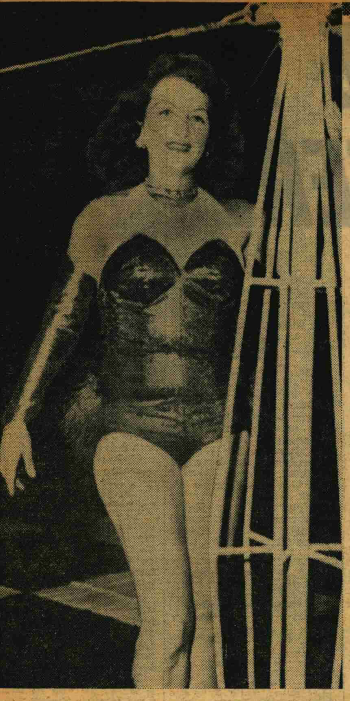
In the following year it was Yetta Wallenda (married name referred to as Mrs Arthur Grotefent) who met her death at Omaha Nebraska, in a fall before a crowd of nearly 5,000, her lifeless body on the concrete floor and the subject of a picture in the reporting newspaper. Having been balancing on top of a 50 foot high pole she lost that fine balance and in falling so gracefully as it was observed, the audience thought it might have been part of the act. The truth was more that she had blacked out and like Richard Faughan the previous year she had complained of not feeling very well before the performance but determined to carry on. Her husband watched her fall and as the previous year, many of the audience were left in tears. Whatever tragedy occurred Karl, as head of the group, was determined that the ‘show must go on.’
In 1970 a documentary film entitled ‘A Walk in the Sun’ was shown on BBC TV. In 1972 Karl’s son in law Richard Guzman aged 29 was killed in an accident while performing. In his case he touched an overhead electric cable which caused him to lose his balance.
On March 22nd 1978, Karl, at 73 years of age met his death as he was walking a high wire in Puerto Rico and a gust of wind blew him off balance when he fell. At the time he was performing 120 feet above the ground.
Four days after his great uncle had been killed, Steve Wallenda fell but was able to continue as he fell onto a tram cable wire at Oakland Zoo in California. He got back up and completed the blindfolded, quarter mile walk along the wire.
Sources and acknowledgements;
The Three Alizés
The British Library Newspaper Archive via Findmypast
https://paperspast.natlib.govt.nz/imageserver/newspapers/P29pZD1FRzE5MzgwNzI2JmdldHBkZj10cnVl
https://eresources.nlb.gov.sg/newspapers/Digitised/Article/singfreepressb19380705-1.2.54
https://www.alamy.com/stock-photo/rotterdam-three-alizes.html?sortBy=relevant
https://www.museeducirquealainfrere.com/Les_Tresors/Les_Alizes/Les_Alizes.html
The Flying Wallendas
With thanks to the British Library Newspaper Archive via Findmypast.
https://www.circusesandsideshows.com/performers/wallenda.html
https://archicedac.archiui.com/oggetti/101-tragedia-al-circo




